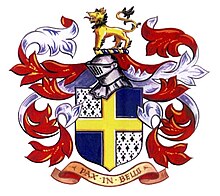The Duke of Leeds | |
|---|---|
 Portrait by Johann Kerseboom, c. 1704 | |
| Treasurer of the Navy | |
| In office 1668–1673 | |
| Monarch | Charles II |
| Preceded by | The Earl of Anglesey |
| Succeeded by | Edward Seymour |
| Chief Minister of Great Britain Lord High Treasurer | |
| In office 24 June 1673 – 26 March 1679 | |
| Monarch | Charles II |
| Preceded by | The Lord Clifford of Chudleigh |
| Succeeded by | The Earl of Essex |
| Lord President of the Council | |
| In office 14 February 1689 – 18 May 1699 | |
| Monarchs | William III and Mary II |
| Preceded by | The Earl of Sunderland |
| Succeeded by | The Earl of Pembroke and Montgomery |
| Personal details | |
| Born | 20 February 1632 |
| Died | 26 July 1712 (aged 80) |
| Parents |
|
Preview warning: Page using Template:Infobox officeholder with unknown parameter "other_titles"

Thomas Osborne, 1st Duke of Leeds, KG (20 February 1632 – 26 July 1712) was an English Tory politician and peer.[1] During the reign of Charles II of England, he was the leading figure in the English government for roughly five years in the mid-1670s. Osborne fell out of favour due to corruption and other scandals. He was impeached and eventually imprisoned in the Tower of London for five years until James II of England acceded in 1685. In 1688, he was one of the Immortal Seven who invited William of Orange to depose James II during the Glorious Revolution. Osborne was again the leading figure in England's government for a few years in the early 1690s before dying in 1712.[2]
- ^ Also known by his earlier and then subsidiary titles of 2nd Baronet, of Kiveton, in the Baronetage of England, 1st Viscount Osborne, in the Peerage of Scotland, and 1st Baron Osborne, 1st Viscount Latimer, 1st Earl of Danby and 1st Marquess of Carmarthen in the Peerage of England.
- ^ Knights, Mark. "Osborne, Thomas, first duke of Leeds (1632–1712)". Oxford Dictionary of National Biography (online ed.). Oxford University Press. doi:10.1093/ref:odnb/20884. (Subscription or UK public library membership required.)